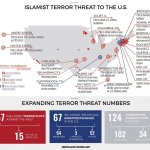The full House of Representatives 8 page report is here.
KEY TAKEAWAYS
• The jihadist threat in the U.S. homeland is high and has escalated dramatically this year. There have been more U.S.-based jihadist terror cases in 2015 than in any full year since 9/11. The number of U.S. terrorist cases involving homegrown violent jihadists has gone from 38 in July 2010 to 124 today—more than a three-fold increase in just five years.
• ISIS is fueling the Islamist terror wildfire across the globe at unprecedented speed. As of the end of August, the group has inspired or directed 57 terror attack plots against Western targets, including 15 in the United States. A recent train attack in France would have been a mass-casualty attack had it not been for an alert group of Americans. There have now been nearly twice as many ISIS-linked attack plots against the West this year (37) as there were in all of 2014 (20).
• Islamist terrorists are intent on killing American law enforcement and military personnel, in addition to innocent civilians. Radicals are increasingly targeting men and women in uniform here in the United States. In August, ISIS supporters released another “hit list” of American government personnel, including service members. Since early 2014, the majority of Islamist terror plots on U.S. soil have featured plans to kill police or U.S. service members.
• ISIS has largely maintained its terror safe havens in Syria and Iraq while expanding globally more than a year after the U.S. and its allies launched operations against it. Al Qaeda affiliates from Syria to Yemen have also carved out sanctuary and seized additional terrain. ISIS retained control over its major strongholds in Syria and Iraq while undertaking disruption attacks and offensives in key territory; ISIS-affiliated militants have simultaneously consolidated control in Libya. Foreign fighters continue to swell the ranks of Islamist extremist groups looking to recruit foot soldiers and activate followers to launch attacks in their home countries.
HOMEGROWN ISLAMIST EXTREMISM
The jihadist threat in the U.S. homeland is high and has escalated dramatically this year.
By the numbers
• Since September 11, 2001, there have been 124 U.S. terrorist cases involving homegrown violent jihadists. Over 80 percent of these cases—which include plotted attacks and attempts to join foreign terrorist organizations—have occurred or been disrupted since 2009.1
• Authorities have arrested or charged at least 52 individuals in the United States this year – 67 since 2014 – in ISIS-related cases. The cases involve individuals: plotting attacks; attempting to travel to join ISIS overseas; sending money, equipment and weapons to terrorists; falsifying statements to federal authorities; and failing to report a felony.2
• FBI Director James Comey has said authorities have hundreds of open investigations of potential ISIS-inspired extremists that cover all 56 of the bureau’s field offices in all 50 states. He stated there may be hundreds or thousands of Americans who are taking in recruitment propaganda over social media applications: “It’s like the devil sitting on their shoulders, saying ‘kill, kill, kill.”
Recent Developments
• August 24: Ahmed Mohammed El Gammal, 42, was arrested in Avondale, Arizona, for helping a 24-year-old New York City resident travel to Syria to receive military training from ISIS. El Gammal was an avid ISIS supporter online and engaged the recruit through social media before in-person meetings. El Gammal and the recruit communicated with an unnamed co-conspirator based in Turkey.
TERROR PLOTS AGAINST THE WEST
ISIS is fueling the Islamist terror wildfire across the globe at unprecedented speed.
By the numbers
• Since early 2014, there have been 57 planned or executed ISIS-linked terror plots against Western targets, including 15 inside in the United States.3
• There have been nearly twice as many ISIS-linked plots against Western targets in the first seven months of this year (37) than in all of 2014 (20).4
Recent Developments
• August 21: A 25-year-old Moroccan national, Ayoub El Khazzani, attacked passengers on a train in Thalys, France, before a group led by three Americans, including two service members on vacation, subdued him. Khazzani was armed with an arsenal of weapons and 270 rounds of ammunition. He watched a jihadist propaganda video before attempting to launch his attack. He had lived in and attended a radical mosque in Spain before relocating to France. He had also lived in Belgium and traveled from Germany to Turkey in early May before returning to Europe in June. This trip was reportedly part of a plot to fight with ISIS in Syria.
• August 13: ISIS’s “hacking division” released information regarding 1,400 American government personnel, including service members, and encouraged supporters to track down and attack them. The list included names, e-mail addresses, and phone numbers. ISIS operative and hacker Junaid Hussain had been central to similar plots targeting servicemembers; Hussain was eliminated in an August 24th drone strike in Syria.
FOREIGN FIGHTERS
Undeterred by airstrikes, foreign fighters continue to pour into the conflict zone in Syria and Iraq, bolstering ISIS and representing a potential threat to their home countries—including America—upon return.
By the numbers
• More than 25,000 fighters from 100 countries have traveled to Syria and Iraq to join extremists—the largest convergence of Islamist terrorists in world history. U.S. estimates reportedly put its current manpower at 20,000-30,000 members. “We’ve seen no meaningful degradation in their numbers” since last August, according to a defense official.
• Approximately 4,500 Western fighters have traveled to Syria and Iraq.5 Europol recently assessed that the high-end estimate of EU citizens who left to fight in Syria may have been as high as 5,000 at the beginning of this year.
• An estimated 550 Western women have traveled to the conflict zone.

